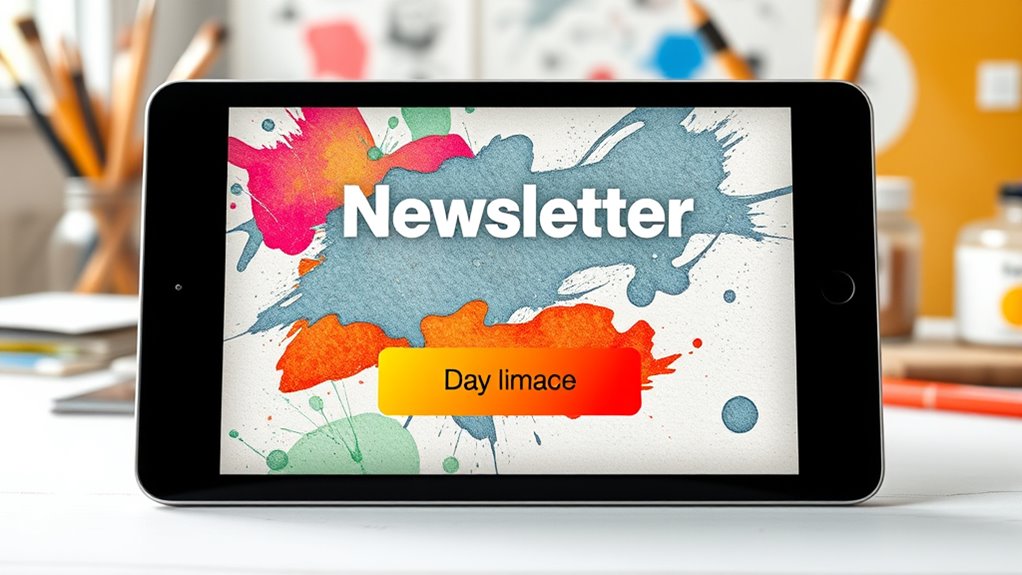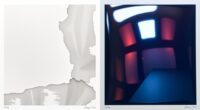To craft effective calls-to-action for your art newsletter, keep your messages clear and action-oriented, like “Discover” or “Join.” Integrate social media buttons seamlessly, making it easy for your audience to share or connect instantly. Personalize your CTAs based on your readers’ preferences to increase relevance and engagement. Use eye-catching visuals and create a sense of urgency to motivate quick responses. Exploring these strategies further can help you create powerful, clickable prompts that truly connect with your audience.
Key Takeaways
- Use clear, action-oriented language that prompts immediate engagement, such as “Discover,” “Join,” or “Share.”
- Incorporate visually appealing elements like buttons and contrasting colors to make CTAs stand out.
- Personalize CTAs based on audience data to increase relevance and effectiveness.
- Integrate social media links and sharing options for seamless connection and broader reach.
- Test and analyze CTA performance regularly to refine messaging and optimize engagement.

A compelling call-to-action (CTA) can make all the difference in an art newsletter, guiding your readers to engage, share, or take the next step. When you craft an effective CTA, you’re not just asking for attention—you’re creating a clear pathway for your audience to connect more deeply with your art and brand. To do this successfully, consider how social media integration can amplify your message. Incorporate direct links to your social platforms, making it easy for readers to follow, share, or comment. Whether you want them to view a new exhibition, share an artwork, or join a live event, embedding social media buttons within your newsletter streamlines the process, encouraging immediate action. This seamless integration makes your CTA more accessible, reducing friction and increasing the likelihood of engagement.
A strong CTA with social media links boosts engagement and connects your audience more deeply with your art and brand.
Personalization strategies also play a *vital* role in crafting compelling CTAs. When you tailor your message to your audience’s preferences and behaviors, it becomes more relevant and persuasive. Use data from previous interactions or preferences to customize your CTA. For example, if a subscriber has shown interest in landscape paintings, your CTA could invite them to explore a new collection or attend an upcoming outdoor exhibition. Personalization makes your readers feel valued and understood, which boosts the chances they’ll act on your call to action. Combine this with social media integration by encouraging personalized sharing—such as inviting them to post with a specific hashtag or tag your account—further extending your reach.
Your CTA should be straightforward, urgent, and action-oriented. Use clear language that leaves no room for ambiguity. Phrases like “Discover our latest collection,” “Join the conversation,” or “Share your favorite piece” set expectations and motivate immediate responses. Pair these with visual cues—buttons, bold fonts, or contrasting colors—that make the CTA stand out within your newsletter. Remember, the goal is to make it as easy as possible for your audience to take that next step. Whether it’s clicking a link, sharing a post, or signing up for an event, your CTA should remove barriers and encourage quick action.
Finally, test and analyze your CTAs regularly. Track click-through rates and engagement metrics to see what resonates most with your audience. Adjust your social media integration tactics and personalization strategies based on this data, continuously refining your approach. When you combine a clear, compelling CTA with thoughtful integration and personalization, you create a powerful tool that fosters stronger relationships and enhances your art newsletter’s impact. Incorporating insights from AI Security can also help optimize your engagement strategies for better results.
Frequently Asked Questions
How Can I Personalize Calls-To-Action for Diverse Art Audiences?
To personalize calls-to-action for diverse art audiences, you should use personalization strategies like addressing recipients by name and tailoring content to their interests. Audience segmentation helps you categorize your subscribers based on their preferences, allowing you to craft relevant CTAs. By understanding what each segment values most, you can create compelling, targeted calls-to-action that resonate, increase engagement, and foster stronger connections with your art audience.
What Metrics Best Measure CTA Effectiveness in Art Newsletters?
Imagine you send an art newsletter and notice a 2% engagement rate but a high conversion percentage from clicks to sign-ups. These metrics reveal your CTA’s success. To measure its effectiveness, track engagement rate to see how many open and interact with your CTA, and conversion percentage to gauge how many take the desired action. Together, these metrics help you refine your calls-to-action for better results.
How Often Should I Include CTAS in My Art Newsletter?
You should consider your timing frequency and placement strategy carefully when including CTAs in your art newsletter. Typically, adding a CTA once or twice per issue works well—too many can overwhelm readers. Place your CTAs strategically, like near your main content or at the end, to maximize engagement. Monitor your metrics and adjust the timing frequency to find the sweet spot that encourages action without overwhelming your audience.
Are Visual Elements More Effective Than Text for CTA Buttons?
You wonder if visual elements are more effective than text for CTA buttons. Visuals often grab attention faster, especially when you consider color psychology—bright, contrasting colors can evoke emotions and prompt action. Button placement is vital; position your CTA where users naturally look, like near engaging content or images. Combining compelling visuals with strategic placement makes your CTA more effective, increasing click-through rates and engagement.
How Do I Discourage Recipients From Ignoring My Calls-To-Action?
To prevent your audience from ignoring your calls-to-action, focus on engagement strategies and audience segmentation. Make your CTAs clear, compelling, and relevant to each segment. Use action verbs, create urgency, and personalize messages to resonate. Test different designs and placements regularly. By tailoring your approach and keeping your audience engaged, you encourage active participation and guarantee your calls-to-action stand out and get noticed.
Conclusion
By mastering your calls-to-action, you’ll turn your art newsletter into an unstoppable force, transforming casual readers into passionate collectors and loyal fans. Picture your words igniting a wildfire of excitement, spreading like lightning through their inboxes, sparking an unstoppable wave of engagement that crashes over every corner of the art world. With every compelling CTA, you’re not just inviting action—you’re releasing a creative revolution that’ll change everything for your art journey.









